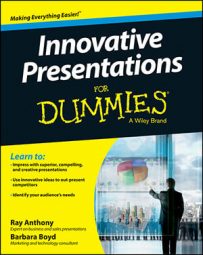Here is an example to demonstrate the innovative presentation's law of emphasis and intensity. Suppose you're driving at night, and from far away you see the high-intensity lights of a police car. The brilliantly vivid, flashing, colored lights immediately capture your sight, even with all the traffic around you. They stand out!
If you attend a symphony performance and in the middle of the adagio — the slow, soft passage of the musical piece — two cymbals clash, that instantaneously adds musical thunder to the ensemble and gives you an auditory jolt. It shouts out!
Or you attend a conference in Las Vegas in an air-conditioned casino and then step outside in the July summer to suddenly experience an oven-blast temperature of 118 degrees Fahrenheit that seems to singe your skin. Immediately, you feel the sensation, the overpowering difference — that, again, stands out!
Each of these audio, visual, or physical sensations exemplify the Law of Emphasis and Intensity in action. The sudden and strong change you experience with sight, sound, touch, taste, and other sensation affects you in an intense way.
If you want a key statistic, vital fact, or point to vividly stick out in your presentation, use the Law of Emphasis and Intensity. During your presentation, the audience watches and listens to you, so you can appeal to either, or both, their visual and auditory senses. Physical sensations are a bit harder to conjure during a presentation.
For example, say you fill the page on a flip chart with about 100 round dots using a black felt tip marker then in the middle of those dots, draw one much larger red dot or a big black square. Would eyes be drawn to the red dot or large square immediately among all the other dots? Of course.
The non-conforming shape stands out from the uniform crowd of dots. The different color, size, and shape distinguishes it among the dots and emphasizes it.
The other part of the Law of Emphasis and Intensity involves intensity, be it mental, physical, or emotional. It can be an intense sight, sound, smell, touch, or emotional impact. Think back on something you saw, heard, felt, or experienced that surprised, shocked, intrigued, or otherwise got your instantaneous and undivided attention.
Intense pleasure or pain, joy or sadness, overwhelming pride or shame — these all share some eruptive feeling, which at times brings a clear, intellectual insight or creates a simple, positive stranglehold on your emotional state.
The more intense the feeling — positive or negative — the more likely you are to remember it. Any sharply vivid or forceful experience causes you to dwell or ruminate upon it long afterwards. The intense feeling you get from a rousing standing ovation is unforgettable and drowns you in a sea of churning emotions. The Law of Emphasis and Intensity creates and sustains that sensation.
In any type of presentation, you convey your key points and also disseminate other needed, but less relevant details to explain, describe, or expand upon those points or link the key points together. During your presentation, you want to draw attention to certain aspects and make sure your audience immediately digests and remembers those aspects more than other supporting pieces of information.
You need to use imaginative ways to separate necessary, yet supporting, information from your most critical message, main point, or key data.
To apply the Law of Emphasis and Intensity to the key points of your presentation, you have to, in some way, highlight and give special importance and prominence to the point apart and above everything else. As you develop your presentation and identify those key points, think about imaginative ways you can define, stress, and separate the critical points and messages from subordinate information.

